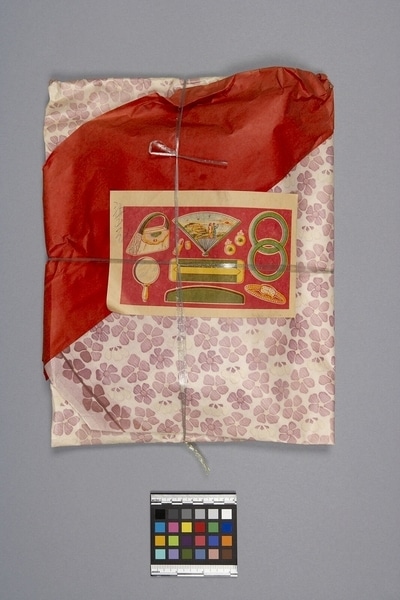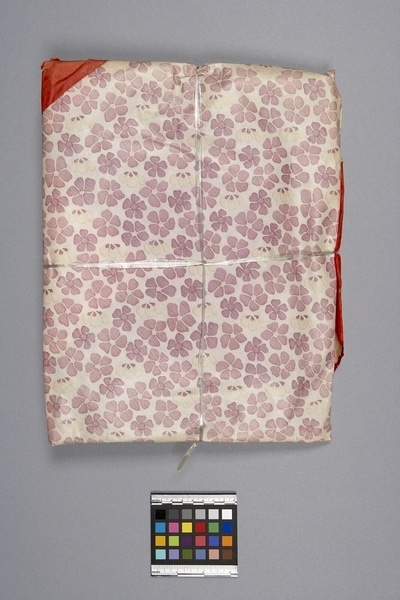Offering Paper Item Number: Edz1111 from the MOA: University of British Columbia


Description
Paper offering consisting of a wrapped paper parcel with purple and off-white floral patterned and red paper bound with grey synthetic twine. Held by the twine is a rectangular piece of paper with a multicoloured printed image depicting a purse, lipstick, a fan, jewellery, a watch, combs, and a mirror.
History Of Use
Hakka and Cantonese people in Hong Kong who practice Chinese popular religion burn paper offerings as a way of transmitting them to gods and ancestors, as do other Chinese sub-ethnic groups. The imagery of the offerings represents actual objects such as clothing, money, gold and silver ingots, and even special objects believed to be desired by individual ancestors such as cars, servants, and houses. People believe that ancestors receive them as actual objects to be used by them in the underworld. These are offered during funeral rituals and at ancestors’ graves and tombs when ancestors are worshipped during festivals dedicated to this purpose, Ching Ming in the spring and Chung Yeung in the autumn. In addition, incense and candles are burned as offerings for both gods and ancestors. People also make offerings of food, wine, and tea to both gods and ancestors. The food offerings are carefully prepared and arranged on serving dishes, and placed on special tables in front of the altars in temples, halls for worshipping ancestors, and shrines dedicated to particular gods. There is a hierarchy of gods and the highest are worshipped first, although not all may be worshipped in sequence. The highest are the Heavenly Gods and individual high-ranking gods with responsibility for particular territories or people in particular occupational or other categories. These gods may have temples devoted to them. Below them are gods responsible for protecting villages, wells, etc. and who have shrines where they are worshipped. Below them are gods who protect households.
There are differences among the ritual practices of various south Chinese sub-ethnic groups. Hakka people worship with a whole chicken, pork, and sometimes a whole roast pig, and squid, as well as fruit. They also do not differentiate the paper offerings, and simply burn them all together. Cantonese people offer them separately, and use a whole chicken, cut up, when worshipping gods, together with a fish, a bowl of rice, and fruit. Hakka people burn incense and candles on the 1st and 15th of the lunar month, while Cantonese people should worship every morning and evening. Low-grade paper offerings are also used to placate ghosts in some situations. Some groups make special offerings to wandering ghosts in the 7th month, when they are released from the underworld. For Hakka people, regular worship is normally performed by women, whereas men are responsible to the Ching Ming and Chung Yeung worship of ancestors, although women assist.
Narrative
From a ritual goods shop in Tsuen Wan, Hong Kong. Enclosed in this package is a complete set of paper representations of a woman’s clothing, including shoes and often also accessories such as a watch and a fan. One or more sets would be burned as an offering to a female ancestor at her funeral and at the annual festivals of Ching Ming and Chung Yeung. Mrs. Kwok Fung, Yin-ha, of Tsuen Wan, Hong Kong, gave invaluable help to Elizabeth Johnson in the selection and purchase of these offering materials and in explaining their meaning and how they were used.
Item History
- Made in Tsuen Wan, Hong Kong, China during 1979
- Collected by Elizabeth L. Johnson during 1979
- Owned by Elizabeth L. Johnson before March 17, 1980
- Received from Elizabeth L. Johnson (Seller) and Museum of Anthropology Shop Volunteers (Funding source) on March 17, 1980
What
- Name
- Offering Paper
- Identification Number
- Edz1111
- Type of Item
- paper
- Material
- paper, ink, paste adhesive and synthetic fibre
- Overall
- height 4.5 cm, width 28.5 cm, depth 35.5 cm
Who
- Culture
- Chinese
- Field Collector
- Elizabeth L. Johnson
- Previous Owner
- Elizabeth L. Johnson
- Received from
- Elizabeth L. Johnson (Seller) and Museum of Anthropology Shop Volunteers (Funding source)
Where
- Holding Institution
- MOA: University of British Columbia
- Made in
- Tsuen Wan, Hong Kong, China
When
- Creation Date
- during 1979
- Collection Date
- during 1979
- Ownership Date
- before March 17, 1980
- Acquisition Date
- on March 17, 1980
Other
- Condition
- good
- Current Location
- Case 83
- Accession Number
- 0610/0081